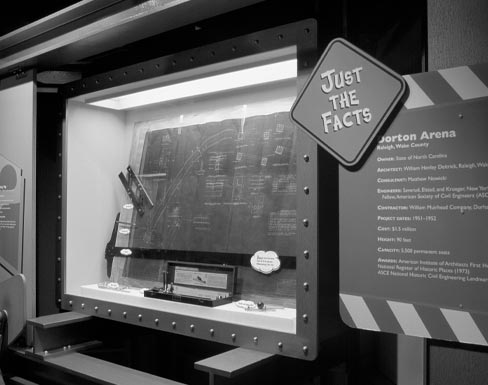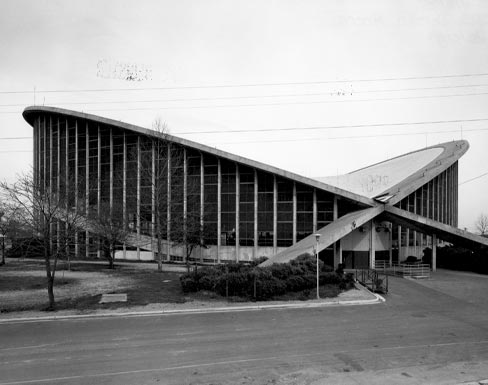Exhibit Review
Man Made Marvels
The North Carolina Museum of History, Raleigh, NC. Exhibit team: Martha Tracy, leader; Jim Cowels, designer; Christopher Graham, curator; Darryl Ketcham, graphic designer; and Wesie Sprunt, registrar
March 2002–September 2005
Traditional museums face a brave new world in the 21st century. Fighting the instant virtual gratification of the information superhighway and the attention span of a sound bite culture, museums must come to terms with new audiences and new exhibit formats. Occasionally this means delving into topics not usually associated with a particular type of museum. The North Carolina Museum of History has taken up this challenge. In 2002, the museum opened Man Made Marvels, an exhibit unlike any previous at the institution. With the statement that "math+science=history," the museum "departed from the traditional historical narrative…to demonstrate how civil engineering has helped shape our state."
Man Made Marvels is a unique exhibit for several reasons. First, the idea came from members of the North Carolina chapter of the American Society of Civil Engineers. Second, a group of eighth-grade students from an area charter school were consulted about aspects of the proposed exhibit during the design phase. Finally, the exhibit features ambitious interactive elements.
The exhibit team took care to choose four principal examples of engineering accomplishments in three geographical regions of the state. The mountainous western portion of North Carolina is represented by two marvels, the Fontana Dam (1941-1945) and the Lynn Cove Viaduct (1978-1983); the central piedmont area by the J.S. Dorton Arena (1951-52) on the North Carolina State Fairgrounds in Raleigh; and the coastal region with the relocation and preservation of the 1870 Hatteras Lighthouse (1999).
Hard-Hat Harry and other cartoon characters guide visitors through Man Made Marvels, introducing the four featured structures. The exhibit text explains the engineering concepts that undergird the construction of the structures. Accompanying each of the principal examples are drawings or models, as well as interactive elements that help to interpret basic engineering principles.
To explain the principles of dam construction, for example, a Fontana Dam model fills with real water. Visitors are asked to select which of three retaining wall shapes will restrain the water. Choose either of the incorrect shapes and the dam drains rapidly, accompanied by the sound of rushing water. For the relocation of the Hatteras Lighthouse, visitors use a hand crank to move a miniature girder and the surrounding sand under the structure, which is viewed through a Plexiglas-covered cross-section.
There is much to recommend Man Made Marvels. The overall design is innovative, and the cartoon characters are an appealing and effective means of presenting complex engineering concepts. The large-scale color activity guide, entitled "Movin' & Shapin'," is an excellent aid to further understanding these design marvels. Most importantly, the exhibit engages middle-school children, challenges them to think about the man-made world around them, and hopefully inspires a few to consider careers as engineers.
The exhibit falls short in one main area, however. Despite being mounted in the North Carolina Museum of History, there is a surprising lack of historical context for these engineering marvels. This is particularly unfortunate as each of the examples chosen are so closely linked to major aspects of North Carolina's social and economic development.
As an example, there is scant historical context for the J.S. Dorton Arena, named by the American Institute of Architects in 1957 as one of the ten most significant "buildings of the future" in the United States. Built as a livestock-judging pavilion for the annual state fair, the design was conceived by internationally known architect Matthew Nowicki, then on the faculty of the School of Design at North Carolina State University. Nowicki designed Poland's Pavilion for the 1939 World's Fair and was on the team of architects that designed the United Nations complex in New York. Nowicki died tragically while the design for the arena was still on the drawing board, and the project was completed by another North Carolina architect, William Henley Deitrick. The arena's innovative tensile steel-supported roof served as inspiration for other landmark buildings of the era, including Eero Saarinen's TWA terminal in New York and the Houston Astrodome. Strangely, the exhibit does not mention the structure's importance as an architectural landmark. As a result, the exhibit is not as engaging to an adult audience as it could be.
Man Made Marvels is an excellent exhibit that shows how museums can reach beyond traditional parameters to engage new topics and audiences. Preservationists will be intrigued. The approach is fresh and creative, and helps to bring the North Carolina Museum of History into the 21st century.
Kenneth Joel Zogry
University of North Carolina at Chapel Hill



